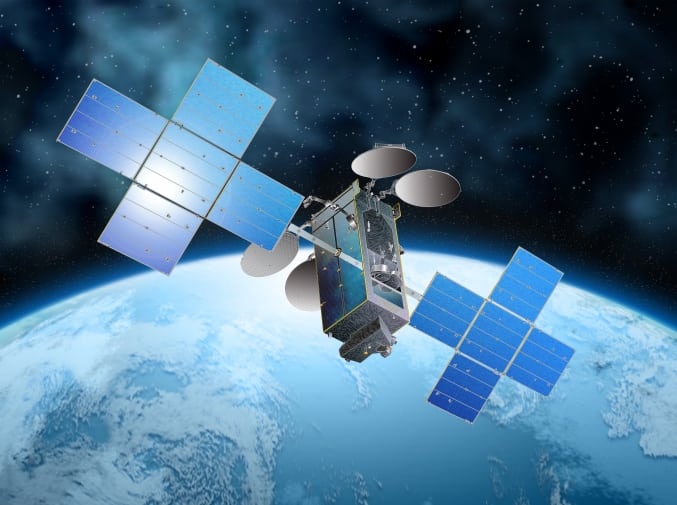Hughes Jupiter-3 Satellite Pushed to Early 2023, EchoStar Explores Potential Acquisitions

Rendition of EchoStar24/Jupiter 3 satellite. Photo: SSL.
Hughes Network Systems pushed back the launch for its anticipated Jupiter-3 satellite once more, announcing Thursday that launch is now expected in the first quarter of 2023. In the previous update, it was expected in the fourth quarter of this year.
Hughes parent company EchoStar Corporation reported first quarter 2022 financials on Tuesday, including the Jupiter 3 update and a discussion of potential EchoStar acquisitions from new CEO and President Hamid Akhavan.
“Maxar has provided an updated schedule and we now expect to launch Jupiter-3 in the first quarter of 2023. This delay is due in part to reallocation of critical resources at Maxar to a higher priority government-related spacecraft project,” Hughes President Pradman Kaul said. “Although we’re disappointed with the delay, we remain highly excited about Jupiter-3, as it will bring significant additional capacity to our markets, as well as the ability to offer high-speed service plans as demanded by our customers.”
A Maxar spokesperson said in a statement to Via Satellite that EchoStar is a valued customer and the company is working hard to complete the Jupiter-3 satellite. “Maxar’s manufacturing facilities are very active building a multitude of government, civil and commercial customer satellites,” the company representative said. “Maxar complies with all legal directives and regulations requiring prioritization of government missions while ensuring we maintain our commitment to customer-focused solutions and service.”
Maxar did not provide further information on the “government-related spacecraft project” Kaul described, but Maxar is also readying its own WorldView Legion satellite for launch with a SpaceX launch window from May 15 to June 13.
Jupiter-3 is a high-throughput Geostationary Orbit (GEO) satellite that will provide capacity over the United States, Canada, Mexico, Brazil, and more countries in South America. When the satellite order was placed in August 2017, Hughes targeted a launch in early 2021, but the launch has since been delayed multiple times.
Kaul told investors it is too early to discuss specifics for service plans for Jupiter-3.
Q1 Financial Results
EchoStar reported total revenue of $502 million for the first quarter, with $494 million in revenue attributed to the Hughes subsidiary. Consolidated revenue increased 3.9% year over year primarily driven by higher equipment sales of $30.5 million to domestic and international enterprise customers, partially offset by lower service revenues of $11.5 million, due to lower broadband consumer customers.
Net income was $88.9 million, an increase of $11.4 million year over year. The increase was primarily due to lower net interest expense and favorable gains on foreign exchange.
In the first quarter, approximately 64% of Hughes segment revenue was attributable to consumer customers with approximately 36% attributable to our enterprise customers.
Hughes continued a streak of subscriber decline, shedding 56,000 subscribers in the quarter and ending Q1 with 1,406,000 subscribers. The company said it is balancing capacity utilization with subscriber levels in areas of high bandwidth demand. In Latin America, subscriber levels were also impacted by adverse economic conditions, more selective customer screening, and capacity allocation to community Wi-Fi and enterprise opportunities.
Kaul said on the investor call that OneWeb gateways are driving equipment sales. He said Hughes has a strong backlog for equipment and it is expected to be a strong part of 2022 performance.
Kaul also provided additional information on the flat panel antenna announced in March. The antenna is still in development. Hughes built a prototype for demonstrations and expects it to be in production early next year. Kauls aid that Hughes will sell the flat panel to any customer, it is not exclusive to OneWeb. the antenna is designed for mobility use cases versus consumer broadband.
“Potential customers are very excited because it’s a revolutionary new technology, no moving parts, very low profile, making it ideal for mobility and aeronautical applications,” Kaul said.
Exploring Acquisitions
EchoStar’s new CEO and President Hamid Akhavan said on the investor call that the company is undergoing a “fresh reassessment of our resources and opportunities and an examination of our industry and adjacent verticals, with the goal to reignite and refine our corporate growth profile.”
Akhavan said the company is exploring both organic growth and acquisitions. He highlighted EchoStar’s strong balance sheet, global presence, trusted reputation, engineering capabilities, and S-band spectrum assets.
“We will be more active in terms of using our cash and our abilities to expand our business using our resources,” Akhavan said. “I think the market is heading in a direction where opportunities will be cheaper and better to acquire, and I look forward to using our resources even more optimally as that happens.”
Akhavan did go into much detail, but shared that potential acquisitions would take the company’s technology into new markets, versus acquiring new technology.
“How do we take these technologies into new markets, adjacent markets? How can we gain scale where [if we were to do it] organically, it might take too long? We accelerate in some of the areas where we have capabilities, through acquisitions,” Akhavan.